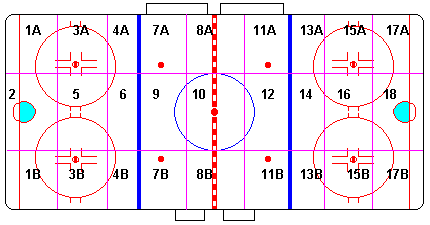
ZONE AND TACTICAL THEORY
Last modified 09/26/2002
PLEASE NOTE: THIS IS A WORK IN PROGRESS. Some of the statements below may not be agreeable to your own personal philosophy (what......?). I will be building and changing each section repeatedly over the next month or so. This is conceptual work and with the limited time that I have to work on it, it may appear disjointed and probably confused (yes...it is!) My first objective it to get the main concepts down and then build on them. So, patience please.
Zone and tactical theory is based on the concept that within the game of hockey exists many specific zones that have specific characteristics inherent the location. This may be relative to skill, combativeness, endurance, speed, etc. As in the "Art of War" by Sun Tzu, this concept was critical to the success of his troops in times of war. Conceptually, terrain played in integral part of armed conflict. Characteristics of hill-war fare were different than those of swamp war-fare, urban war-fare different that those on an open field.
What I will do in this page is to form a correlation between zone, tactics and skill. The following pages may be a little long winded but bear with me.
Zone size in some way is dependant on the skill level of the individual and/or team. A Tyke or Novice player conceptually organizes his game play based on his limited skills. Chip and bump in traffic and get to open ice, skate hard until you run into something. A highly skilled NHL player can alter his tactics meter to meter down the ice.
There are then two basic schools of thought. One tactically based on zone and its inherent characteristics relative to team play and the other is based on individual skills (one on ones).
To start, we will analyze zone specific characteristics.
As shown below, the surface can be broken up into different zones. While some of these zones can be "similar" such as corners (4 of them), there are characteristics that are slightly different. Two zones are offensive and 2 are defensive, one side is to the goal-tenders blocker side, one to the glove, and so on. The objective here is to describe each zone with its inherent attributes and build strategies that identify strengths and weaknesses either in team tactics or player skills.

The following flow chart represents how zone characteristics effect skill and tactical training and systems.
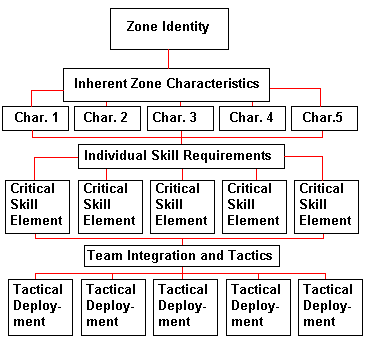
In the following pages, I will progress through each zone as shown in the above flow chart and when, all is said and done, move into drill and system practice plans once the animated program that I am working on becomes a little more familiar. Good luck understanding all of this. Please email me some feed back. RON
1 - The corner zones (1A, 1B, 17A, 17B)
Inherent characteristics:
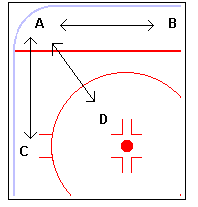


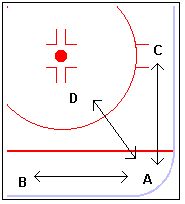
|
Zone Rating based on skill, combative, intelligence, endurance (type), and speed 1 - minimal 3 - fair 5 - average 7- moderate 10 - maximal |
|||
|
Description: Corner Zone 1 - 3 basic lanes to enter or exit. characteristics: Into or out of using the side wall lane, into or out of using low back lane or into or out of through mid ice.
2 - sealed off on two sides Side characteristics: Tall or short end glass, tall or short side glass, high or low mid boards, lively or dead mid boards, inset or flush dasher board setup, yield or unyielding glass system, coarse or groomed edges, shallow or deep corner, strong or weak base board rebounds, line visibility (yes, believe it or not) and ice conditions. |
|||
|
Skill Description |
D-zone Rating |
O-zone Rating |
Corner zones 1a, 1b, 17a, 17b |
|
Skating Short game skills (0-30 ft) |
10 |
10 |
Most skill required for success especially acceleration, crossovers, tight turns |
Skating - Transitional skills (30-60 ft) |
4 |
4 |
Average skill required for success but must be able to increase speed once open to drive to net. |
|
Skating - Long game skills (60 - 100 ft) |
1 |
1 |
Not a major requirement |
|
Puck handling |
10 |
10 |
Most skill required for success especially when accelerating, performing crossovers and tight turns. Must be able to protect puck while accelerating into open ice. |
|
Stick handling |
10 |
10 |
Most skill required for success. Quick hands, strong stance a must. |
|
Intelligence. |
8 |
9 |
Get open, get to the net is basic requirement of offense. Defensive posture is primarily focused on awareness of time and pressure which translates into low, medium and high risk options. To coin a phrase by Dave King, low risk/high reward options are critical to a team's success. |
|
Passing |
5-10 |
10 |
Defensive zone passing under high pressure ranks a 10. However, if partners screens off or assists, variables can change. Offensive passing is a must and is absolutely critical to goal opts. |
|
Reception |
7 |
9 |
Reception skills on defense are rather basic and simple yet do require high success rate. Offensive reception is critical to goal scoring especially when catch and release for shooting skills. |
|
Shooting |
8 |
5 |
I ranked defensive shooting important from a clearing perspective. Off the glass and out with power and accuracy becomes a problem under high pressure. Offensive shooting skills from this zone are minimal but a quick, accurate well timed shot could score. |
|
Combative |
10 |
10 |
Most combative place in the rink. Critical to a teams success. Control the corners, control the game. |
|
Endurance |
10 |
10 |
Anaerobic - very intense. Strong on skates with much upper body work through core, arms, shoulder. |
Tactics:
1 - Breakout; strong side rim (base/mid board, glass), quick up , reverse, clear (baseboard, wall, glass, or over glass and out of play), over, over and back, far-side rim, far-side direct.
2 - Dump; rim, corner strong side, cross corner, flip
3 - Cycle; into corner, out of corner
4 - Puck freeze; high, mid and low corner
5 - Rebound to; blocker side, glove side
6 - face-off: blocker side, glove side, even strength, odd man, push, draw, tie-up.
7 - Combative: Even strength (1/1, 2/2, 3/3)
8 - Combative: Odd man advantage (2/1, 3/2)
9 - Picks: Aggressive, passive (Ref, opposition)
10 - Defensive draw (by offense pulling defense to corner/away from net): Cut-back or delay
11- Offensive draw (by defense pulling forecheck to corner/outside lane): Cut-back or delay
12 - Icing the puck
Skills:
1 - skating
a - turns: Gliding, tight turns (yes, there are several types)
b - crossovers
c - Heel drive
d - quick starts
e - quick stops
f - gliding
g - forward to back ward pivots
h - backward to forward pivots
i - control skating
j - changing speeds
2 - puck handling
*same as above but carrying puck
- use of skates
3 - stick handling
a - puck protection: forecheck (side angle, chase)
b - 1/1: face to face (width and depth)
c - Goal-tender deke
4 - combative
a - puck freeze: skates and stick
b - picks: aggressive and passive (inside out, outside in, blind side)
c - puck protection (offensive side, defensive side)
d - regain possession (levering, push off, step-in, clutch and grab)
e - aggressive use of stick: (stick lift, hook and step, push and stagger)
f - hitting: hip, shoulder (high, low)
g - receiving/absorbing hit (high, low)
5a - face-offs (center)
a - push: forehand and backhand sides, skates (vertical, diagonal, horizontal)
b - draw: forehand and backhand sides, skates (vertical, diagonal, horizontal)
c - tie-up: forehand/backhand sides.
d - drop and freeze
5b - face-offs (wing/defense)
a - tie-up (off-wing, natural side)
b - pick (off-wing, natural side)
c - fast break
d - drive
e - screen
f - step back
6 - passing (long and short)
a - forehand: direct, touch (deflect/redirect), saucer, flip, chip, one-time
b - backhand: direct, touch (deflect/redirect), saucer, flip, chip, one-time
c - glove pass (defensive zone)
d - skate: inside, outside
e - bank/rebound pass: (glass, mid-board, baseboard) forehand and backhand
7 - reception
a - stick: forehand/backhand
b - skates: inside/outside skate
c - glove: palm, back of
d - control (bouncing puck) forehand, backhand, skate, glove, body
e - cup and release (shot): forehand and backhand
8 - shooting
a - wrist
b - backhand
c - snap (forehand/backhand)
d - slap
e - flip (forehand/backhand)
f - chip (forehand/backhand)
g - one-time (forehand/backhand)
9 - Miscellaneous
a - anticipation (reading off of combative situation - turnover and transition to off/def)
b - reactive (getting into position as fast as possible off of read)
c - concentration
d - awareness
e - communication: verbally, body language
f - listening
g - discipline
Success within this zone defensively (while static or in motion) require the following: Strong skating skills such as quick starts, stops, turns, and bursts of speed either in a straight line or on a curve. Strong combative skills require strength, quickness, deceptiveness through use of arms, body and stick. Strong communication skills (talking and listening) as well as a comprehensive understanding of the tactical applications based on one on one (offensive side, defensive side) skills such as man-on-man responsibilities (coverage, getting open, etc) and two on ones based on support (aggressive/near-close and passive/close-far).
1 - The Net Zones (2A, 2B, 2C, 2D)
Inherent characteristics:
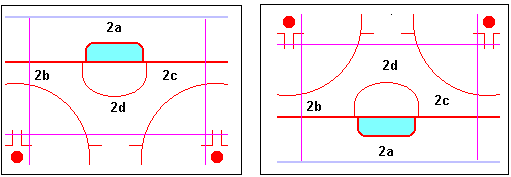
|
Zone Rating based on skill, combative, intelligence, endurance (type), and speed 1 - minimal 3 - fair 5 - average 7- moderate 10 - maximal |
|||
Description: Net Zone 1 - 3 basic lanes to enter or exit. characteristics: Into or out of using the side wall lane, into or out of using low back lane or into or out of through mid ice.
2 - sealed off on two sides Side characteristics: Tall or short end glass, tall or short side glass, high or low mid boards, lively or dead mid boards, inset or flush dasher board setup, yield or unyielding glass system, coarse or groomed edges, shallow or deep net lane, strong or weak base board rebounds, line visibility (yes, believe it or not) and ice conditions, net placement. |
|||
|
Skill Description |
D-zone Rating |
O-zone Rating |
Net Zones 2a, 2b, 2c, 2d |
|
Skating Short game skills (0-30 ft) |
10 |
10 |
Most skill required for success especially acceleration, crossovers, tight turns when protecting puck, driving to net, coming out from behind net, reacting to puck movement, etc |
Skating - Transitional skills (30 - 60 ft) |
6 |
2 |
Average offensive skill required for success but must be able to increase speed once open to drive to net. Defensive skill is important to react to rebound, etc. |
|
Skating - Long game skills (60-100ft) |
5 |
10 |
Not a major requirement except for some breakout attempts and attacking lane off of an outside drive. |
|
Puck handling |
9 |
9 |
Second most important skill required for success especially when accelerating, performing crossovers and tight turns. Must be able to protect puck while accelerating into open ice or to the net |
|
Stick handling |
10 |
10 |
Most skill required for success. Quick hands, strong stance a must. |
|
Intelligence. |
8 |
10 |
Get open, get to the net is basic requirement of offense |
|
Passing |
5-10 |
10 |
Defensive zone passing under high pressure ranks a 10. However, if partners screens off or assists, variables can change. Offensive passing is a must and is absolutely critical to goal opts. |
|
Reception |
7 |
10 |
Reception skills on defense are rather basic and simple yet do require high success rate such as on a reverse, over, over and back, etc. Offensive reception is critical to goal scoring especially when catch and release for shooting skills (one-time shots) |
|
Shooting |
8 |
10 |
I ranked defensive shooting important from a clearing perspective. Off the glass and out with power and accuracy becomes a problem under high pressure. Offensive shooting skills from this zone are minimal but a quick, accurate well timed shot could score. |
|
Combative |
8 |
8 |
Most combative place in the rink. Critical to a teams success. Control the slot, control the game. Net drives, crash the net, go to the net are terms depicting play in this area. |
|
Endurance |
6 |
6 |
Anaerobic - very intense. Strong on skates with much upper body work through core, arms, shoulders. |
Tactics:
1 - Breakout; strong side rim (base/mid board, glass), quick up , reverse, reverse and over, over, over and back, far-side rim, far-side direct, clear (baseboard, wall, glass, or over glass and out of play),
2 - Dump; rim, strong side corner to seam, far side corner to seam, end wall, goaltender dump and play.
3 - Weak side cycle; into corner, out of corner, behind net
4 - Puck freeze; on net, back wall, goal-tender freeze
5 - Rebound to; shallow slot, behind net, blocker side, glove side
6 - Combative: Even strength (1/1, 2/2, 3/3 - front of net and back of net on wall)
7 - Combative: Odd man advantage (2/1, 3/2 - front of net and back of net on wall)
8 - Picks: Aggressive, passive (Ref, opposition)
9 - Screens
10 - Defensive draw (by offense pulling defense to corner/away from net): Cut-back or delay
11- Offensive draw (by defense pulling forecheck to corner/outside lane): Cut-back or delay
12 - Icing
Skills:
1 - skating
a - turns: Gliding, tight turns (yes, there are several types)
b - crossovers
c - Heel drive (cut to seam and step in)
d - quick starts
e - quick stops
f - forward to back ward pivots
g - backward to forward pivots
h - control skating
i - changing speeds
2 - puck handling
*same as above but carrying puck
- under extreme pressure
- use of skates
3 - stick handling
a - puck protection: forecheck (side angle, chase)
b - 1/1: face to face (width and depth)
4 - combative
a - puck freeze: skates and stick
b - picks: aggressive and passive (inside out, outside in, blind side)
c - puck protection (offensive side, defensive side)
d - regain possession (levering, push off, step-in, clutch and grab)
e - aggressive use of stick: (stick lift, hook and step, push and stagger)
f - hitting: hip, shoulder (high, low)
g - receiving/absorbing hit (high, low)
5b - face-offs (wing/defense)
a - tie-up (off-wing, natural side)
b - pick (off-wing, natural side)
c - fast break
d - drive
e - screen
f - step back
6 - passing (long and short)
a - forehand: direct, touch (deflect/redirect), saucer, flip, chip, one-time
b - backhand: direct, touch (deflect/redirect), saucer, flip, chip, one-time
c - glove pass (defensive zone)
d - skate: inside, outside
e - bank/rebound pass: (glass, mid-board, baseboard) forehand and backhand
7 - reception
a - stick: forehand/backhand
b - skates: inside/outside skate
c - glove: palm, back of
d - control (bouncing puck) forehand, backhand, skate, glove, body
e - cup and release (shot): forehand and backhand
8 - shooting
a - wrist
b - backhand
c - snap (forehand/backhand)
d - slap
e- flip (forehand/backhand)
f - chip (forehand/backhand)
g - one-time (forehand/backhand)
9 - Miscellaneous
a - anticipation (reading off of combative situation - turnover and transition to off/def)
b - reactive (getting into position as fast as possible off of read)
c - concentration
d - awareness
e - communication: verbally, body language
f - listening
g - discipline
h - quick release shooting skills
Success within this zone defensively (while static or in motion) require the following: Strong skating skills such as quick starts, stops, turns, and bursts of speed either in a straight line or on a curve under extreme pressure due to nature of zone (closest to net and scoring opportunity). Strong combative skills require strength, quickness, deceptiveness through use of arms, body and stick behind the net and in the slot. Strong communication skills (talking and listening) as well as a comprehensive understanding of the tactical applications based on one on one (offensive side, defensive side) skills such as man-on-man responsibilities (coverage, getting open, etc) and two on ones based on support (aggressive/near-close and passive/close-far).
I will endeavor to break down both zones comprehensively moving through each of the above tactics, basing the decision making process down into a binary progression. This binary set of progressions is based on puck location, puck direction, player position (offensive/defensive), relative position of checking player/s (speed, distance), etc. I will be animating this process on my other web site (www.hockeyschoolonline.ca) at a later time, within a month or so.....hopefully so as to better understand this process so please bear with me.
A player's default system is based on pattern recognition. If a player repeats a specific movement enough times, his ability to recognize this pattern and possible outcomes becomes somewhat intuitive. Once a play develops outside this pattern however, everything mentally slows down to as to better read options. A comparison to this is similiar to the car radio scenario. In a familiar neighborhood, we can have many distractions (car radio on, talking, etc) and navigate very easily the turns, breaking, accelerating, etc. However, in unfamiliar territory, to many distractions become a problem and we either slow down or turn everything off so as to navigate easier (take in more information). We can say the same thing when driving on country roads and then driving in a busy city where it takes far more concentration to negotiate turns, stops, etc. This is what happens when a player jumps to a higher level to soon, the "country to city" transition becomes overwhelming and the decision making process slows down significantly.
An interesting phenomena occurs if we continue to drive in dense city traffic. We start to sequence events and start to recognize certain patterns; when to anticipate light changes, lane changes, other driver movements, movements of pedestrians, location of street signs, etc. We then start to create and utilize an "operational system of city drivers and pedestrians". We start to group drivers into basic categories; slow, normal and radical (or idiots...kidding). As well, we start to learn how much time we have to make decisions to turn, stop, etc based on signage, lights, or other drivers. In essence we create a survival default system that allows us to operate safely in a very busy, hectic environment. Not much different than hockey right. Unfortunately, the drivers (skaters), signage (events), are hard to categorize because most of our training has been subjective (based on what a particular coach thinks) not objective (what is actually happening within the REAL game). For example, a common mistake is during breakout practice where a coach teaches a low pressure breakout pattern and then the players introduce it into a game with no success. What happens is that a basic pattern (this particular breakout) is just a foundation of movement from which options arise based on pressure. If we only create on outcome, the forecheck has to fall within this pattern or there is very little chance of success.
The following diagrams are designed to create basic default pattern systems from which a player either expands on a 1/1 situation into a variety of 2 on one options. This can become very complicated (I have written a book on this that covers approximately 450 pages and 850 diagrams on just breakout variables alone) and I will endeavor to simplify this as much as possible. GOOD LUCK!!!
In the diagram below, I have shown both corner and net zones. I will break down these zones specific to puck movement so as to build a binary system that we can utilize.

In this first series of Offensive plays, the objective is to make the goaltender handle the puck. Tactically, benefits are many. (a) Dump and Freeze: face-off superiority and options that result. (b) Handle and Play: options that may result off of a bad puck handle or pass. (c) Net Stop: Options that may result off of miss-handle, poor setup, poor communication with defense.

I will not go into detail here about :dump and freeze" or "dump and play" options, but suffice it to say that, how many goals have we seen over the years in the NHL been the result of a miss-handle or miss-pass. Remember a few? The primary objective of a dump-in is to CREATE an opportunity by application of pressure through either; angle of dump, type (flip, slap etc.) speed or location.
In the following diagram, the dump-in is from the seam with the objective to create a shallow to deep rebound (left side drawing) or to use the wall / corner to rebound the puck inside out. This type of play creates blind-side defenseman pivots if the puck is dumped from an inside position (between two def.). Problems with pivots, screen outs, and puck retreval are again the main objectives of inside out wall dump play.

The object of the following plays (strong side) as shown below are to bring the puck back to the seam forcing perhaps a bad pivot, retreval, or support play. In the Cross-corner play, the objectives are to either; force a bad pivot and/or retreval or, puck pick-up by support player.

3 - The Side Wall Zones (3A, 3B, 15A, 15B)
Inherent characteristics:
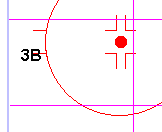
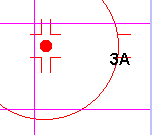
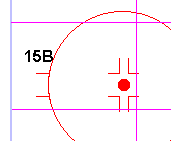
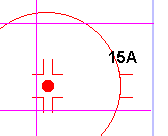
|
Zone Rating based on skill, combative, intelligence, endurance (type), and speed 1 - minimal 3 - fair 5 - average 7- moderate 10 - maximal |
|||
Description: Side Wall Zones 1 - 3 basic lanes to enter or exit. characteristics: Into or out of using the side wall lane, and/or into or out of using mid ice.
2 - sealed off on one side Side characteristics: Tall or short end glass, tall or short side glass, high or low mid boards, lively or dead mid boards, inset or flush dasher board setup, yield or unyielding glass system, coarse or groomed edges.. |
|||
|
Skill Description |
D-zone Rating |
O-zone Rating |
Side wall zones |
|
Skating Short game skills (0-30ft) |
8-10 |
8 |
Moderate skill required. Primarily, quick acceleration (off wall on breakout), crossovers (on swing support or breakout or cycle). Quick stops on cutbacks, etc. |
|
Skating - Transitional skills (30-60ft) |
8 |
6 |
Defensively more important on breakout fundamentals. Crossovers off of cycle. |
Skating - Long game skills (60-100ft) |
4 |
8 |
Not a major requirement except for breakout attempts and attacking lane off of an outside drive. |
|
Puck handling |
5 |
7 |
Second most important skill required for success especially when accelerating, performing crossovers and tight turns. Must be able to protect puck while accelerating into open ice or to the net on cycle or when carrying puck into open ice off of breakout. |
|
Stick handling |
5 |
5 |
Average skill. Most one on ones in this zone pertain to delay options and puck protection off of cycle. |
Intelligence |
6 |
8 |
Get open for breakout pass, understand options off of breakout, read offensive options to outside either from zone entry and top of circle penetration to corner exit and drive off of cycle. |
|
Passing |
5-10 |
8 |
Passing from this zone defensively to mid ice, near side bank, weak long pass. |
|
Reception |
8-10 |
8 |
Reception skills on defense are rather basic and simple yet do require high success rate. Offensive reception is critical to goal scoring especially when catch and release for shooting skills. |
|
Shooting |
8 |
10 |
I ranked defensive shooting important from a clearing perspective. One of the problems in this area is trying to clear or pick up the puck on a rim play. Chipping the puck through the middle or off the glass or wall is a difficult skill especially when under high pressure. Offensive shooting skills from this zone come from either a quick shot off the cycle, pass from down low, an over pass (such as on a power play) to a quick shot (slap, snap or wrist) from the rush. |
|
Combative |
8 |
6 |
Combative action comes from a pinching defenseman and more or less is limited to getting the puck out of the zone. |
|
Endurance |
4 |
6 |
Defensive play is minimal. Offensive play is moderate especially when cycling. |
Tactics:
1 - Breakout; strong side rim (base/mid board, glass), quick up , far-side rim, far-side direct, clear (baseboard, wall, glass, or over glass and out of play, to middle ), or wall freeze
2 - Dump; hard rim, far side corner to wall, end wall to top of circle.
3 - Weak side cycle; into corner, out of corner.
4 - Puck freeze; side wall
5 - Rebound to; high slot, corner rim to top of circle.
6 - Combative: Even strength (1/1, 2/2, 3/3 ) off of failed breakout attempt (rim or otherwise) or cycle, PP, etc.
7 - Combative: Odd man advantage (2/1, 3/2 ) off of breakout, delay, cycle, PP, etc
8 - Picks: Aggressive, passive (Ref, opposition) - high - inside out, outside in.
9 - Defensive draw (by offense pulling defense to corner/away from net): Cut-back or delay
10- Offensive draw (by defense pulling forecheck to corner/outside lane): Cut-back or delay
11 - Icing
Skills:
1 - skating
a - turns: Gliding, tight turns (delays, cycle and cut back, breakout, etc)
b - crossovers (delays, cycle, breakout, etc)
c - Heel drive (cut to seam and step in) off of cycle.
d - quick starts - forwards and backwards (off wall into open ice/ moving to wall for breakout, etc)
e - quick stops (delays, off the rush, breakout, etc)
f - forward to back ward pivots (off rush facing play, winger moving into position, etc)
g - backward to forward pivots (facing puck offensively then driving to net, defense on regroup moving up ice, etc)
h - control skating (reading off of forecheck)
i - changing speeds (breakout - PP for example, offensive wide drive, etc)
2 - puck handling
*same as above but carrying puck
- under extreme pressure
- use of skates
3 - stick handling
a - puck protection: forecheck (side angle, chase) - cycle (over-the-top)
b - 1/1: face to face (width and depth) - offense (net attack).
4 - combative
a - puck freeze: skates and stick
b - picks: aggressive and passive (inside out, outside in, blind side) off breakout and offensive cycling as well as specialty teams.
c - puck protection (offensive side, defensive side)
d - regain possession (levering, push off, step-in, clutch and grab)
e - aggressive use of stick: (stick lift, hook and step, push and stagger)
f - hitting: hip, shoulder (high, low)
g - receiving/absorbing hit (high, low)
5b - face-offs (wing/defense)
a - tie-up (off-wing, natural side)
b - pick (off-wing, natural side)
c - fast break
d - drive
e - screen
f - step back
6 - passing (long and short)
a - forehand: direct, touch (deflect/redirect), saucer, flip, chip, one-time
b - backhand: direct, touch (deflect/redirect), saucer, flip, chip, one-time
c - glove pass (defensive zone)
d - skate: inside, outside
e - bank/rebound pass: (glass, mid-board, baseboard) forehand and backhand
7 - reception
a - stick: forehand/backhand
b - skates: inside/outside skate
c - glove: palm, back of
d - control (bouncing puck) forehand, backhand, skate, glove, body
e - cup and release (shot): forehand and backhand
8 - shooting
a - wrist
b - backhand
c - snap (forehand/backhand)
d - slap
e- flip (forehand/backhand)
f - chip (forehand/backhand)
g - one-time (forehand/backhand)
9 - Miscellaneous
a - anticipation (reading off of combative situation - turnover and transition to off/def)
b - reactive (getting into position as fast as possible off of read)
c - concentration
d - awareness
e - communication: verbally, body language
f - listening
g - discipline
h - quick release shooting skills
Copyright © 1996 by Ron Johnson. All rights reserved.